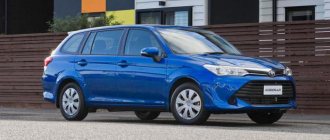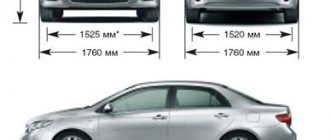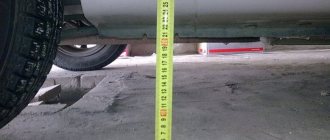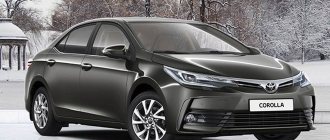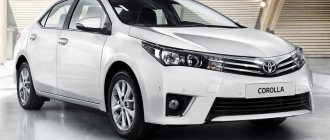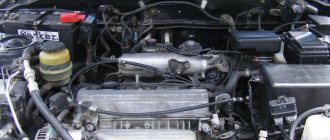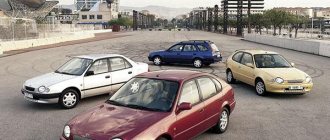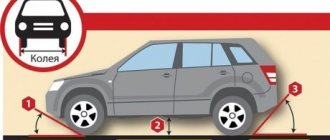The 11th generation Toyota Corolla sedan (E160 body) in Russia is equipped with three four-cylinder naturally aspirated engines: 1.33 (99 hp, 128 Nm), 1.6 (122 hp, 157 hp) and 1.8 (140 hp, 173 Nm). The first two power units migrated to the updated car from the previous generation car (150 body), losing 2 hp each. power (previously the output was 101 and 124 hp, respectively). The “senior” 1.8-liter engine is a newcomer, since it was not presented on the Russian market before the change of generations.
The trio of power plants is complemented by two transmission options: a 6-speed manual and a 7-speed MultiDrive S CVT with torque converter. A manual transmission is paired with 1.33 and 1.6 engines, and a CVT is combined with 1.6 and 1.8 liter engines.
The sedan is available in front-wheel drive. The suspension is built around the front MacPherson struts and the rear semi-independent beam. During the change of generations, the chassis configuration was revised, in particular, the strut damping settings and the torsion beam mounting scheme changed.
Fuel consumption of a Toyota Corolla with an initial 1.33-liter engine and manual transmission, according to the passport data, does not exceed 5.6 liters per 100 km in a combined driving cycle. A sedan with a 1.6-liter engine consumes an average of 6.6 (with manual transmission) or 6.3 (with CVT) liters. Toyota Corolla 1.8 consumes no more than 6.4 liters per 100 km.
Technical characteristics of Toyota Corolla table:
| Parameter | Toyota Corolla 1.33 99 hp | Toyota Corolla 1.6 122 hp | Toyota Corolla 1.8 140 hp | |
| Engine | ||||
| engine's type | petrol | |||
| Injection type | distributed | |||
| Supercharging | No | |||
| Number of cylinders | 4 | |||
| Cylinder arrangement | in-line | |||
| Number of valves per cylinder | 4 | |||
| Volume, cubic cm. | 1329 | 1598 | 1798 | |
| Power, hp (at rpm) | 99 (6000) | 122 (6000) | 140 (6400) | |
| Torque, N*m (at rpm) | 128 (3800) | 157 (5200) | 173 (4000) | |
| Transmission | ||||
| Drive unit | front | |||
| Transmission | 6 manual transmission | 6 manual transmission | variable speed drive | variable speed drive |
| Suspension | ||||
| Front suspension type | independent MacPherson type | |||
| Rear suspension type | semi-dependent | |||
| Brake system | ||||
| Front brakes | ventilated disc | |||
| Rear brakes | disk | |||
| Steering | ||||
| Amplifier type | electric | |||
| Tires and wheels | ||||
| Tire size | 195/65 R15 | 205/55 R16 | ||
| Disk size | 6.0Jx15 | 6.5Jx16 | ||
| Fuel | ||||
| Fuel type | AI-95 | |||
| Environmental class | Euro 5 | |||
| Tank volume, l | 55 | |||
| Fuel consumption | ||||
| Urban cycle, l/100 km | 7.2 | 8.7 | 8.2 | 8.3 |
| Extra-urban cycle, l/100 km | 4.7 | 5.4 | 5.3 | 5.3 |
| Combined cycle, l/100 km | 5.6 | 6.6 | 6.3 | 6.4 |
| dimensions | ||||
| Number of seats | 5 | |||
| Number of doors | 4 | |||
| Length, mm | 4620 | |||
| Width, mm | 1775 | |||
| Height, mm | 1465 | |||
| Wheelbase, mm | 2700 | |||
| Front wheel track, mm | 1535 | 1525 | ||
| Rear wheel track, mm | 1535 | 1520 | ||
| Front overhang, mm | 940 | |||
| Rear overhang, mm | 980 | |||
| Interior dimensions LxWxH, mm | 1930x1485x1190 | |||
| Trunk volume, l | 452 | |||
| Ground clearance (clearance), mm | 150 | |||
| Weight | ||||
| Curb, kg | 1225-1355 | 1260-1375 | 1275-1380 | |
| Full, kg | 1735 | 1775 | 1785 | |
| Weight of towed trailer (equipped with brakes), kg | 1000 | 1300 | ||
| Weight of towed trailer (not equipped with brakes), kg | 450 | |||
| Dynamic characteristics | ||||
| Maximum speed, km/h | 180 | 195 | 185 | 195 |
| Acceleration time to 100 km/h, s | 12.6 | 10.5 | 11.1 | 10.2 |
Toyota Corolla engines
1.33 1NR-FE Dual VVT-i 99 hp
The basic small-displacement engine of the NR series dates back to 2008. The engine is equipped with an aluminum liner cylinder block, a distributed injection system, phase shifters on both shafts (Dual VVT-i), an electronically controlled throttle valve (ETCS), a crankshaft with 4 counterweights (the axis is shifted by 8 mm relative to the cylinder axis), hydraulic compensators for correcting gaps in the valve mechanism, timing chain drive, EGR (exhaust gas recirculation) system with valve drive from a stepper motor.
1.6 1ZR-FE Dual VVT-i 122 hp
The engine was first introduced in 2007. Design features - aluminum block, 16-valve timing (DOHC), valve timing control on both shafts (Dual VVT-i), hydraulic compensators, distributed injection. The Valvematic system (valve lift control) is not provided for engines installed on Russian versions of the sedan.
1.8 2ZR-FE Dual VVT-i 140 hp
And the 2ZR-FE is structurally similar to the 1ZR-FE with all the ensuing pros and cons. The main difference from its “younger” brother is a different crankshaft and a piston with a stroke increased to 88.33 mm. In terms of traction characteristics, the 1.8-liter unit is only slightly superior to its partner in the engine range.
| Parameter | 1.33 99 hp | 1.6 122 hp | 1.8 140 hp |
| Engine code | 1NR-FE | 1ZR-FE | 2ZR-FE |
| engine's type | petrol without turbocharging | ||
| Supply system | distributed injection, dual electronic valve timing control system Dual VVT-i, two camshafts (DOHC), timing chain drive | ||
| Number of cylinders | 4 | ||
| Cylinder arrangement | in-line | ||
| Number of valves | 16 | ||
| Cylinder diameter, mm | 72.5 | 80.5 | 80.5 |
| Piston stroke, mm | 80.5 | 78.5 | 88.33 |
| Compression ratio | 11.5:1 | 10.2:1 | 10.0:1 |
| Working volume, cubic meters cm. | 1329 | 1598 | 1798 |
| Power, hp (at rpm) | 99 (6000) | 122 (6000) | 140 (6400) |
| Torque, N*m (at rpm) | 128 (3800) | 157 (5200) | 173 (4000) |
Specifics of Asian Corollas
Despite the fact that the model is called the same all over the world, in different countries the cars have always differed from each other. The Japanese liked to make for themselves richer equipment compared to those cars that were exported.
Even in the mid-10s, multimedia with navigation already appeared in the 9th generation Toyota Corolla. For cars of this class at that time it was a luxury. The interior was made in a combination of two colors. The apogee of the difference between Asian and other versions was the all-wheel drive options. There have never been such versions on the Russian market. They simply weren't imported. And if such a car was encountered, it was always right-hand drive and had the designation “Runx”. It is also very difficult to find a Toyota Corolla in a 120 station wagon in our country. The Japanese also made such options only for themselves.
Toyota Corolla gearboxes
The line of transmissions available for the Toyota Corolla is represented by a 6-speed manual transmission and a Multidrive S CVT, which replaced the 4-band automatic transmission. The CVT provides three operating modes: automatic (lever position D), sport (activated by a button) and shiftmatic (lever position M). The latter mode allows you to change gears manually using the selector on the inter-passenger tunnel or the steering wheel paddles.
| Parameter | 6-speed manual transmission | CVT Multidrive S | ||
| 1.33 99 hp | 1.6 122 hp | |||
| Model | EC61 | EC60 | K311 | |
| Gear ratio | 1st gear | 3.538 | 3.538 | — |
| 2nd gear | 1.913 | 1.913 | — | |
| 3rd gear | 1.392 | 1.310 | — | |
| 4th gear | 1.029 | 1.971 | — | |
| 5th gear | 0.875 | 1.818 | — | |
| 6th gear | 0.743 | 1.700 | — | |
| Forward gear | — | — | 2.386-0.411 | |
| Reverse gear | 3.333 | 2.505-1.680 | ||
Specifics of American Corollas
American Corollas are the opposite of Asian ones. Here, manufacturers focused on cheapness and removed everything from the car that could in one way or another indicate some kind of elitism.
The materials used were completely junk, and American journalists called the changes in the exterior starting from the 10th generation a “step back.” The car looked so simple that it was difficult to call it a legend.
Service
Maintenance of the 1NZ engine installed in a Toyota vehicle should be carried out in accordance with the manufacturer's instructions. When undergoing maintenance you must:
- replace the engine oil using the original or one of similar quality and viscosity - the procedure is carried out every 10 thousand km (under severe operating conditions - every 5 thousand km);
- replace the oil filter (at the same time as changing the oil);
- replace the timing chain in combination with installing new sprockets, chain tensioner and guide - the procedure is carried out when the mileage reaches 150-200 thousand;
- adjust valve clearances - every 20 thousand km.
Technical characteristics, tuning
Despite the low fuel consumption, which does not exceed 6.5 liters on the highway, and 8 liters per hundred in the countryside, the car is very playful and maneuverable. For those who like to drive fast, the chassis will have to be modified, since at high speed the car is very rolly, it is advisable to install special sports air-oil shock absorbers. From the factory, the Corolla is equipped with wide-profile tires with a small radius, so the wheels are also replaced with others with a larger radius. The standard headlights, which give off a yellowish tint, are also subject to tuning; they are replaced with brighter ones, and experienced car enthusiasts customize the fuel supply system, which is configured from the factory in such a way as to save fuel as much as possible. Not only the technical part, but also the car body can be subject to changes.
The steering wheel is equipped with an electric power amplifier, thanks to which all efforts made with the steering wheel are quickly transferred to the wheels without any delays.
Exterior and interior 121 models
The appearance of the Toyota Corolla in the 121 body is quite elegant and at the same time smart and sporty. Let's take a closer look at the details of the car. Its head optics are ideally combined with the radiator grille, which, due to chrome plating, stands out significantly among other parts. There is nothing special in the front bumper; fog lights are located along its edges.
The sides of the car do not have any flashy details; everything is done neatly and tastefully. From the rear, the car again stands out with large taillights and a chrome insert. The headlights take up a significant portion of the rear of the car. In addition to this, one pleasant feature can be highlighted - the rear window has a very large area, so if your configuration does not have parking sensors, it will be very convenient to monitor the movement of your Corolla not only in the mirrors, but also by looking at the rear window.
Now it's worth talking about the salon. Like all Corolla models, the 121 has a lot of space inside. 4 adults can easily fit inside, not including the driver. The interior is quite ergonomic and comfortable. The designers did a great job with every detail inside it. The seats in the cabin are quite comfortable.
It is worth saying that a lot depends primarily on the configuration. The quality of materials and the presence of certain comfort options greatly influence the first opinion about a car. It is worth trying to take this car with air conditioning, not to mention climate control and electronic adjustment of seats, steering wheel, mirrors and power windows.
Exterior and interior
The body of this model, thanks to its taut exterior, ideal combination of a chrome radiator grille and head optics, looks elegant. On the edges of the front bumper there are fog lights. Due to the large headlights and large rear window area, the rear of the car stands out.
There is a lot of space inside the Toyota Corolla 121 body, while the interior is very comfortable and ergonomic. The front seats are quite comfortable with excellent lateral support, and in the back seat three adult passengers will feel very comfortable. The quality of materials, as well as what options will be installed in the car, will depend on what equipment the car has. The machine can be equipped with:
- Climate control;
- Electronic adjustment of seats, steering wheel, and mirrors;
- Glasses with electronic drive;
- Air conditioning.
2E
An “ancient” 1.3-liter power unit with a design that was developed back in 1984. As for the Toyota Corolla, 2E was installed until 1998 - almost until the very end of production of the unit. In practice, the 2E did not shine with reliability and service life, but among car enthusiasts it established itself as a “workhorse”. It has a simple design with a carburetor and SOHC cylinder head. The camshaft drives a belt drive. The configuration is quite familiar - an in-line “four” made of cast iron, but the cylinder head here is a 12-valve aluminum one. The most simple motor without phase regulators, hydraulic compensators and other “bells and whistles”. Its cylinders are bored to 73 mm, and the piston moves to 77.4 mm.
The driver only needed to adjust the valve clearances and operate the car as intended. Subject to the conditions, 2E traveled an honest 240 thousand km. Unstable operation of the internal combustion engine is most often caused by incorrect carburetor settings. By putting a car with 2E under the hood in the hands of a professional, it’s easy to get it to work correctly. In second place are problems with the ignition system. The engine is very afraid of overheating and in case of overheating it breaks the cylinder head gasket. The service life of the Toyota Corolla 1.3 engine is not limited to 240,000 kilometers, but usually it is around this mark that the unit must be rebuilt and the rings replaced.
Which generation of Corolla is considered the most reliable?
The ninth generation is considered the most popular generation, which made the Corolla famous. It was the one that sold the most, according to car owners, due to the high degree of reliability of the car and its maintainability. The series was released from 2001 to 2007.
This car can easily be found on Russian roads to this day. Most have never had their engine overhauled. If the oil and wear parts are changed in a timely manner, the car will go as far as it has already.
Disadvantages and weaknesses
Car owners consider the main disadvantages of Toyota Corolla engines to be floating speeds, which arise due to the throttle valve constantly becoming dirty. And it, in turn, becomes polluted due to low-quality fuel.
The timing chain is also weak on late model engines. It serves a maximum of 150,000 kilometers. Some owners complain that it cannot withstand a mileage of 100 thousand km.
The engine periodically stalls at idle. This applies to Corolla engines that have been in service for more than 10 years. This means that the fuel pump and filter devices are not in order.
High engine oil consumption occurs in power units with a mileage of over 150 thousand km. In this case, it is recommended to change the oil pump and check all seals.
2C-E
In 1997, production of the two-liter 2C-E diesel engine began. It was installed on the Toyota E110 until 2001. The 2C series differs from other engines in its electronically controlled high-pressure fuel pump manufactured by Denso. The 2C-E cylinder block is made of cast iron, and the cylinder head (2 valves per cylinder) is made of aluminum. Structurally simple engine with SOHC gas distribution system. The camshaft is driven by a belt. Another feature of the motor is the presence of pre-chambers.
The main complaints from car owners concern the cylinder head. Due to overheating, the cylinder head often cracks. The second most popular problem is valve seats. They are destroyed, and small particles fall into the cylinders and cause irreparable damage to the block. Another place that can become a source of penetration of abrasive into the combustion chambers is the air duct. The timing belt does not have a long service life. It is usually changed after 60-80 thousand km. In the event of a break, the valve bends. Another difficulty in maintaining and repairing the 2C-E diesel engine lies in the complex electronically controlled injection pump. Due to the intricate fuel equipment, sensitive cylinder head and low quality diesel fuel, it lasts an average of 250 thousand km.
